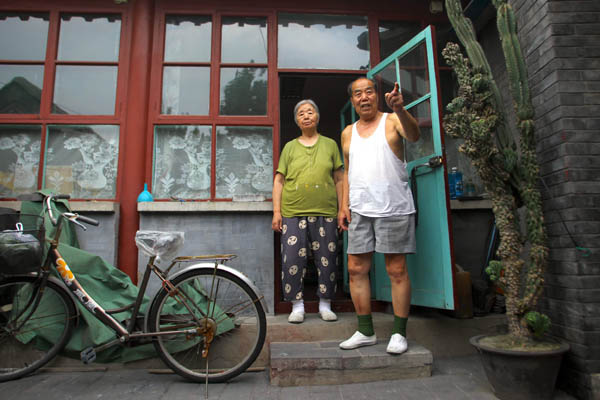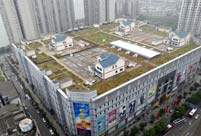 |
| Ma Lingpeng and his wife Meng Zhaohui say they don't want to leave the hutong, where Ma's extended family has lived for more than 200 years. (China Daily/Zou Hong) |
Ma lives in what can be considered the old Beijing. Hidden among tall trees and gray walls, winding hutong and courtyards form the neighborhoods, where people go about everyday life. They buy daily supplies at closet-sized stores, build pigeon nests on the roofs, and visit neighbors without changing their pajamas.
In May, the Xicheng district government announced plans to renovate the Shichahai area. Work on the project, which stretches from Drum and Bell Towers to the north and Ping'an Avenue, including the Baimixiejie Hutong area to the south, will start in September and October.
Plans include an underground square that connects with the Shichahai station of Beijing subway line 8. Two-story buildings along the southern extension of Beijing's central axis will be built in the style of Ming (1368-1644) and Qing (1644-1911) dynasties.
According to Sun Jinsong, director of Xicheng District Information Office, the total investment in this project will be 8.3 billion yuan ($1.4 billion), which covers 15.6 hectares and involves more than 1,000 families living in the area. But the number of residents who will have to move out has not been decided yet.
"We will use the same policy as in Yangmeizhuxiejie of Qianmen area, listening to local residents' wishes," says Sun, referring to the restoration of Qianmen, a well-known hutong neighborhood near Tian'anmen Square. In 2008, the once ramshackle and over-populated area is now a wide pedestrian street.


 DPRK holds military parade to mark 65th founding anniv.
DPRK holds military parade to mark 65th founding anniv. Highlights of MAKS 2013 Int'l Aviation and Space Show
Highlights of MAKS 2013 Int'l Aviation and Space Show  10th China-ASEAN Expo opens in Nanning
10th China-ASEAN Expo opens in Nanning Eagle Boy takes to sky to break another record
Eagle Boy takes to sky to break another record 12-year-old boy becomes pillar of the family
12-year-old boy becomes pillar of the family Eye-gouged boy receives blind rehabilitation in Shanxi
Eye-gouged boy receives blind rehabilitation in Shanxi Top 10 naked hotels in the world
Top 10 naked hotels in the world The most gorgeous Chinese women in the eyes of foreigners
The most gorgeous Chinese women in the eyes of foreigners A collection of bizarre rooftop buildings around China
A collection of bizarre rooftop buildings around China Residences of the royal house of Savoy
Residences of the royal house of Savoy China's frigate 'Bengbu'in fire training
China's frigate 'Bengbu'in fire training Fresh students 'forced' to register in university independently
Fresh students 'forced' to register in university independently 2013 Taiwan Int'l Tourism Expo kicks off in Taipei
2013 Taiwan Int'l Tourism Expo kicks off in Taipei Photo story: Take a gap year
Photo story: Take a gap year Nokia's Global Headquarters: visiting a declining empire
Nokia's Global Headquarters: visiting a declining empireDay|Week|Month